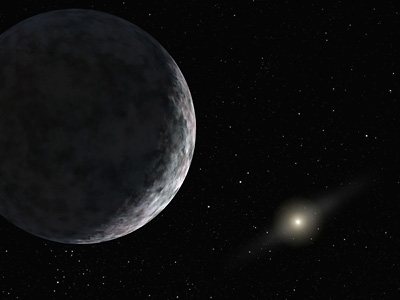Eris is a dwarf planet that orbits the sun in the outer solar system. It has a diameter about equal to that of Pluto. Upon its identification in 2005, Eris became one of the largest bodies of the outer solar system (beyond the orbit of Neptune).


Observations suggest that Eris is about 1,450 miles (2,350 kilometers) in diameter, slightly smaller than Pluto. The orbit of Eris is elongated (oval), ranging from 3.5 billion to 9 billion miles (5.6 billion to 14.5 billion kilometers) from the sun. One complete orbit takes about 557 years. Because of its distance from the sun, Eris has extremely low surface temperatures, around 30 K (–243 °C or –406 °F).
Astronomers think Eris has a core of rock covered with an ice shell. Frozen methane has been detected on Eris’s surface. The surface is shiny, reflecting almost all starlight back into space. In the past, radioactive elements in the core may have heated Eris from the inside, resulting in continual melting and refreezing of the ice above. This process may continue today.
Eris has a small moon, Dysnomia. The moon measures about 1/8 Eris’s diameter.
The American astronomers Michael E. Brown, Chadwick A. Trujillo, and David L. Rabinowitz announced the discovery of Eris on July 29, 2005. They found it in pictures taken in 2003 using the Samuel Oschin Telescope at Palomar Observatory in southwestern California. The Minor Planet Center assigned the newly discovered object the temporary designation 2003 UB313. This center is part of the International Astronomical Union (IAU), the widely recognized authority in naming heavenly bodies. People sometimes informally referred to 2003 UB313 as Xena, a nickname used by the object’s discoverers. In 2006, they named the object Eris for the Greek goddess of chaos and strife. Astronomers first detected the object’s moon on Sept. 10, 2005, at Keck Observatory in Hawaii.
The discovery of Eris intensified an ongoing debate over the definition of the term planet. Some astronomers proposed that the object should be classified as a planet. They suggested this because Eris is about the size of Pluto. At the time, Pluto was widely considered the ninth planet. Other astronomers argued that Eris and Pluto should not be considered planets. They thought they should be grouped instead with thousands of similar but smaller objects found in a region of the solar system called the Kuiper belt. In 2006, the IAU created the term dwarf planet to describe Pluto, Eris, and other similar objects in the solar system. In 2008, the IAU also classified Eris, Pluto, and the other dwarf planets beyond Neptune as plutoids.
See also Dwarf planet; Kuiper belt.
